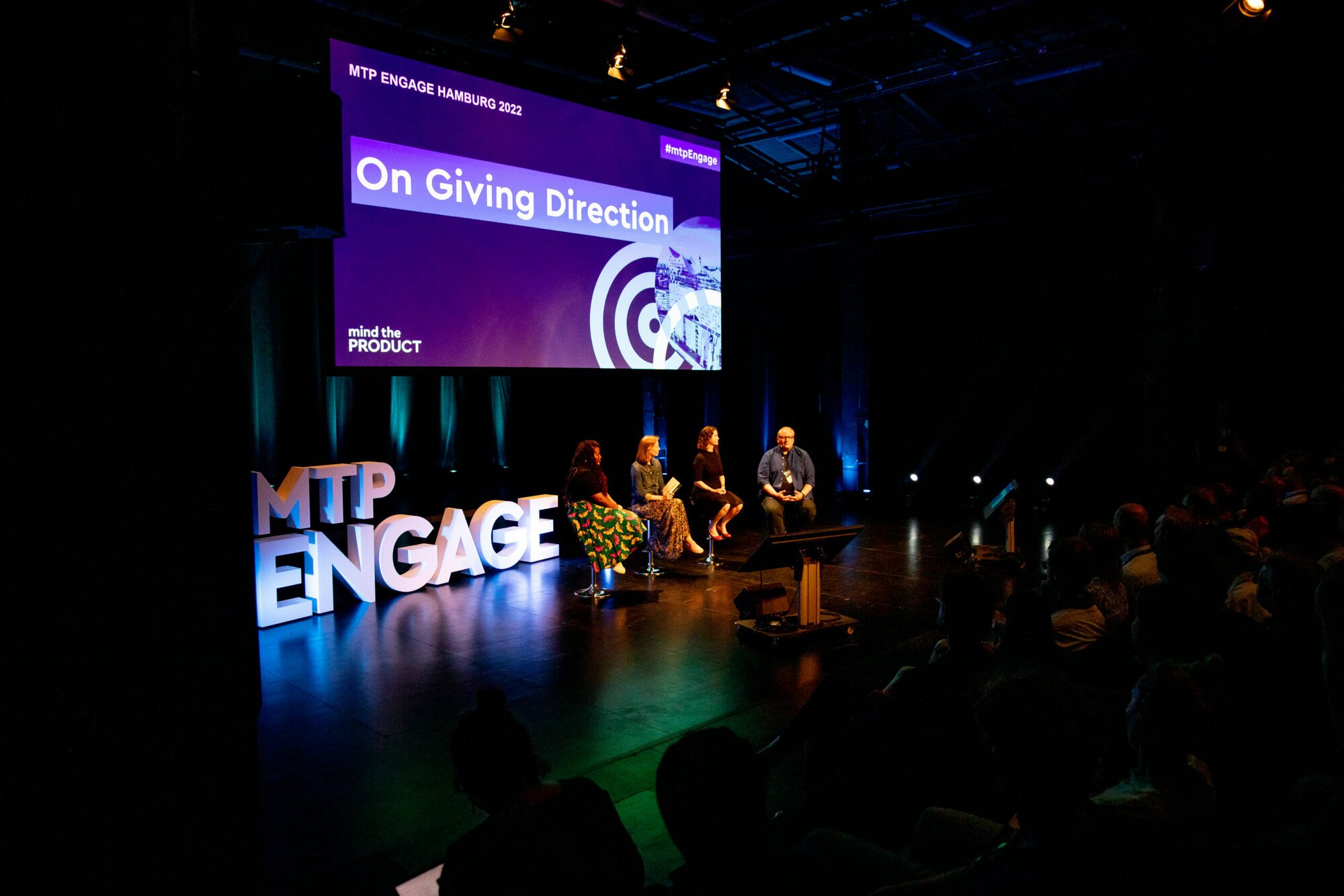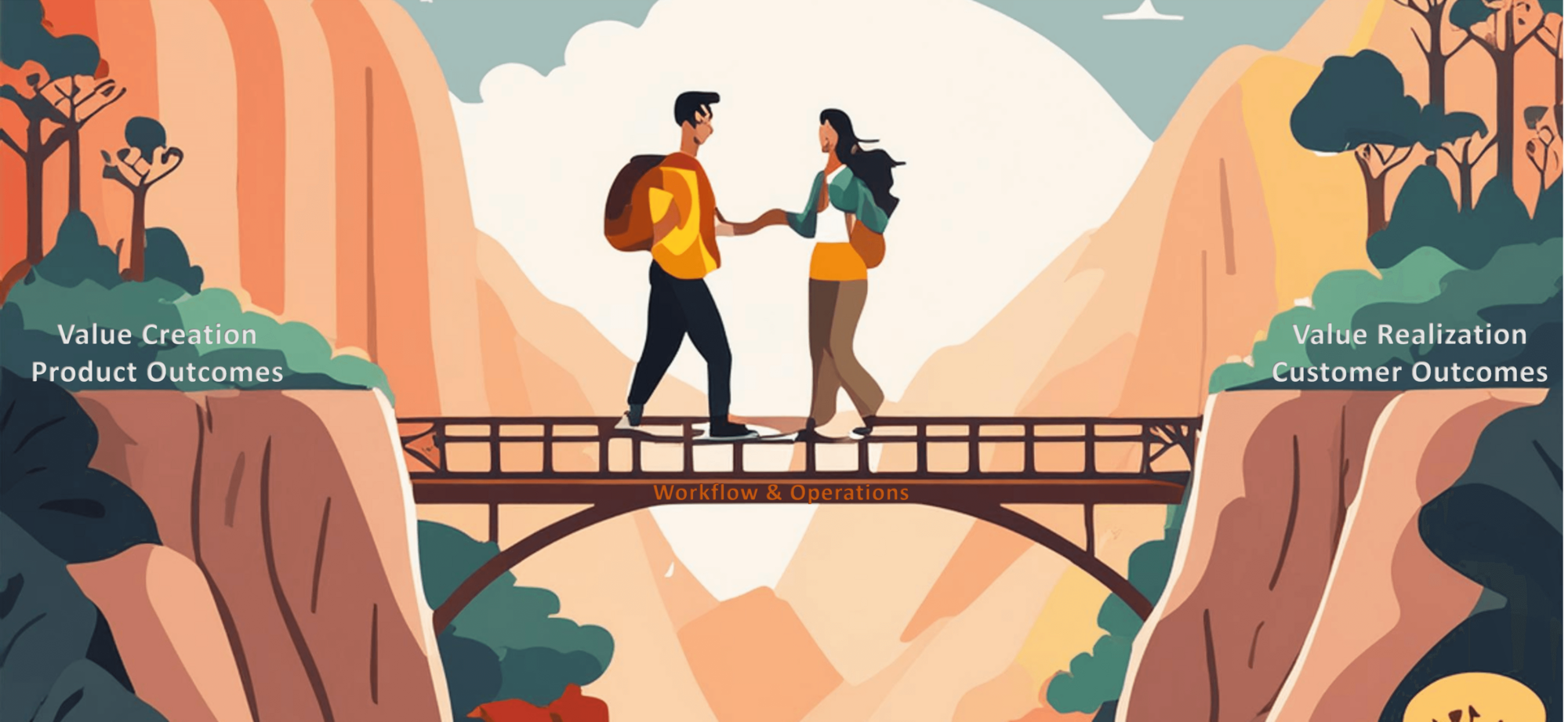This session On Giving Direction as a product manager was one of the themed sessions during MTPEngage Hamburg 2022 (the others were On Being Responsible, On Being Human and On Being User-Oriented). Moderated by Mirja Bester, VP Product at XING, a stellar line-up of speakers shared their respective perspectives on how product leaders or product managers provide others with the necessary orientation to pull in one direction.
- Nacho Bassino spoke about The role of Product Direction in team empowerment
- Janna Bastow spoke about The Skinny on Lean Roadmapping and OKRs
- Chiedza Muguti spoke about You, Me and Strategy
Their three talks culminated in a joint QnA which also included Martin Eriksson whose keynote in the morning already elaborated on Product Strategy and Product Principles as two important aspects of enabling decision making and giving Product Direction. Watch the videos in full or read on for a recap of all three talks:
Overall some of the sentiments shared by the speakers throughout this 90-minute session were:
- Product direction is important to focus the energies of your product teams
- While giving product direction is the primary responsibility of formal product leaders and the most powerful way for them to empower their teams there are also many ways how individual contributors can help to increase clarity about product direction in their context.
- Being intentional about communicating product direction is crucial to make an impact.
Let’s have a closer look at the talks – for more details, you can also check out the recordings above.
Nacho Bassino: The role of product direction in team empowerment
Nacho Bassino is a Product Director at XING, a Product Leadership and Strategy coach and – conveniently for this talk – the author of Product Direction and the host of the great new podcast 100 Product Strategies.
Due to COVID, he could only participate on video which meant that the audience missed his well-rehearsed Tennis-moves which he had planned as a metaphor to illustrate his story.
In his talk, Nacho makes the point that in addition to product delivery (which many teams focus on) and product discovery (which most teams understand they should put more attention on) there’s a third element to successful product work and that is product direction. Product direction should be the first step because it helps teams identify the most important opportunities and clarifies why they are important and how they contribute to the product vision.
What Nacho notices is that unfortunately most product teams don’t have a product direction. They lack a product strategy – even though every product leader would agree the teams will need product direction to focus their work. Reasons for the lack of sufficient product direction are matters of urgency vs. importance (aka: product leaders spend too much time fighting fires and too little time on developing or advancing product direction and strategy) but also difficulties in knowing how to start.
In response to this, one of Nacho’s key messages is that there are plenty of helpful tools and frameworks to choose from if you understand the general four steps of how to develop a product strategy:
- The first of these phases is the Insights phase in which you identify a problem, a tendency or an opportunity that can radically change the game for your product. This insight phase is fed by continuous information gathering and the challenge is how to work with a broad range of opportunities without getting lost or without narrowing in on one aspect prematurely.
As an example of how to address this, Nacho shows how he uses Teresa Torres’ Opportunity Solution Tree to map various opportunities in response to his desired outcomes. The Opportunity Solution Tree encourages a compare and contrast mindset – in other words: Not focusing on the first shiny idea that comes to mind but instead acknowledging that there are several opportunities to achieve the desired outcome. - The second phase is about selecting the most promising opportunities – and actively saying no to all other opportunities. This aspect of saying no as an important element of product direction is one that is also very prominent in Martin Eriksson’s Decision Stack, but still one that many companies “forget” to do.
As an example for how to select between various options, Nacho showed how he uses the Strengthen the Core model to identify how various opportunities benefit from your core value proposition – and if & how they could enhance your core value proposition. - In the third phase of the strategy process, Nacho describes the importance of defining the success criteria for your strategic drivers and of making the hypotheses and risks that you need to validate explicit.
- Lastly in the fourth phase of product strategy development, Nacho points out the importance of synthesizing your product strategy to make it clear and memorable before you communicate it.
Nacho emphasizes that working on Product Direction is not rocket science and that there are tangible steps you can follow in order to work on it.
Janna Bastow: The skinny on lean roadmapping and OKRs

Janna Bastow is a product person by heart, she co-founded Mind the Product as well as ProdPad. She is known for her clear statements on Lean Roadmaps and why the Now, Next, Later format she introduced is favourable over timeline-based roadmaps.
One of Janna’s key statements during this talk is that you should think of your (lean) roadmap as a prototype for your product strategy – which is also why we were very happy to have Janna with us for this session on product direction.
In her talk Janna once more made clear why she sees timeline-based roadmaps as problematic: Since they are full of assumptions that are hard to predict and impossible to control they set the product manager and their team up for failure. They also come with various risks such as missing emerging market opportunities or building the wrong thing altogether.
As a result, she has observed a clear disenchantment with roadmaps in the product community and uses the rest of her talk to convince the audience why roadmaps – if done the lean way – are actually a good thing and how they can be combined with OKRs.
Janna emphasises how lean roadmapping takes the LEARN aspect of Lean’s Build, Measure, Learn. Through the concept of different time horizons (Now, Next, Later) they acknowledge that in between the situation you face right now and the shiny summit in the future there are a lot of uncharted territories.
In particular, when thinking about a (lean) roadmap as a prototype of your strategy it’s important to think of the roadmap as a living artefact that you share and discuss with others and which gets better as a result of these discussions with different perspectives.
By using a lean roadmap as a flexible document that the product manager and their team keep coming back to they can make use of the teams’ full resources.
But Janna argues that in order to get the team on board with this they will need to know what they want to achieve and how they can tell that they are moving in the right direction. In other words: they look for clear objectives.
Here’s where the popular OKR framework comes into play. In order to connect it to the roadmap, Janna points out that in addition to Objectives and Key Results we also need to make explicit by which Initiatives we aim to influence the success of the Objective. Janna didn’t make clear if she actively advocates for renaming OKRs to “OIKRs”, but she clearly showed how Initiatives can help to connect OKRs and the Lean Roadmap:
She proposes that each element on the lean roadmap is an initiative and that each initiative is clearly referenced to an objective.
This also helps to avoid “OKR drift”. Janna refers to the effect that if OKRs are not coupled to what the team works on their attention during the OKR cadence naturally shifts from the OKRs defined at the beginning of the quarter to what the team actually works on.
Or to frame it more positively: By coupling OKRs with Lean Roadmapping from building and delivering features to solving problems in ways that contribute to company objectives.
Janna finished her talk by referring to her 6-page guide for how to ditch your timeline roadmap for further reference on how to bring your team and stakeholders along with this approach
Chiedza Muguti: You, me, and strategy
Chiedza Muguti is a product leader with 14 years of experience in product leadership. She is a proud Zimbabwean and one of her goals is to make product management accessible, in particular to underrepresented groups. With regard to strategy and product direction, she strives to make strategy more tangible and less abstract.
As such her talk focused on what’s important to communicate strategy well.
Chiedza starts with a personal story of her mission as a teenager to go study in the UK and how in retrospect she identified four success factors that made the strategies she and her parents developed for it as success.
Those factors are Clarity, Focus, Empathy and Trust.
And as she shows the same factors are also crucial factors for product strategy.
Chiedza continues to point out the importance of the basic needs of wanting to be heard, wanting to be seen and wanting to be acknowledged are so important when working with people and how because of that it is so important to be intentional in your communication of strategy.
Interestingly what she observes is that in comparison to the time and attention spend on preparing a strategy many leaders spend too little time on communicating it in the best possible way.
To tap into this potential, Chiedza points out several aspects of successful strategy communication.
Those include:
- Being open and vulnerable to encourage honest feedback and contributions
- Planning a combination of different communication formats to involve different groups of people and cater for their communication needs
- Fostering real, bi-directional dialogue
- Meeting people where they are (i.e. participating in team meetings)
- Involving representatives from teams in the preparation to get their perspectives and ideally empower them as influencers.
Overall Chiedza makes the point that it is more important to strive for connection than for perfection and she closes her talk with a very fitting African proverb:
If you want to go fast, go alone. If you want to go far, go together!









